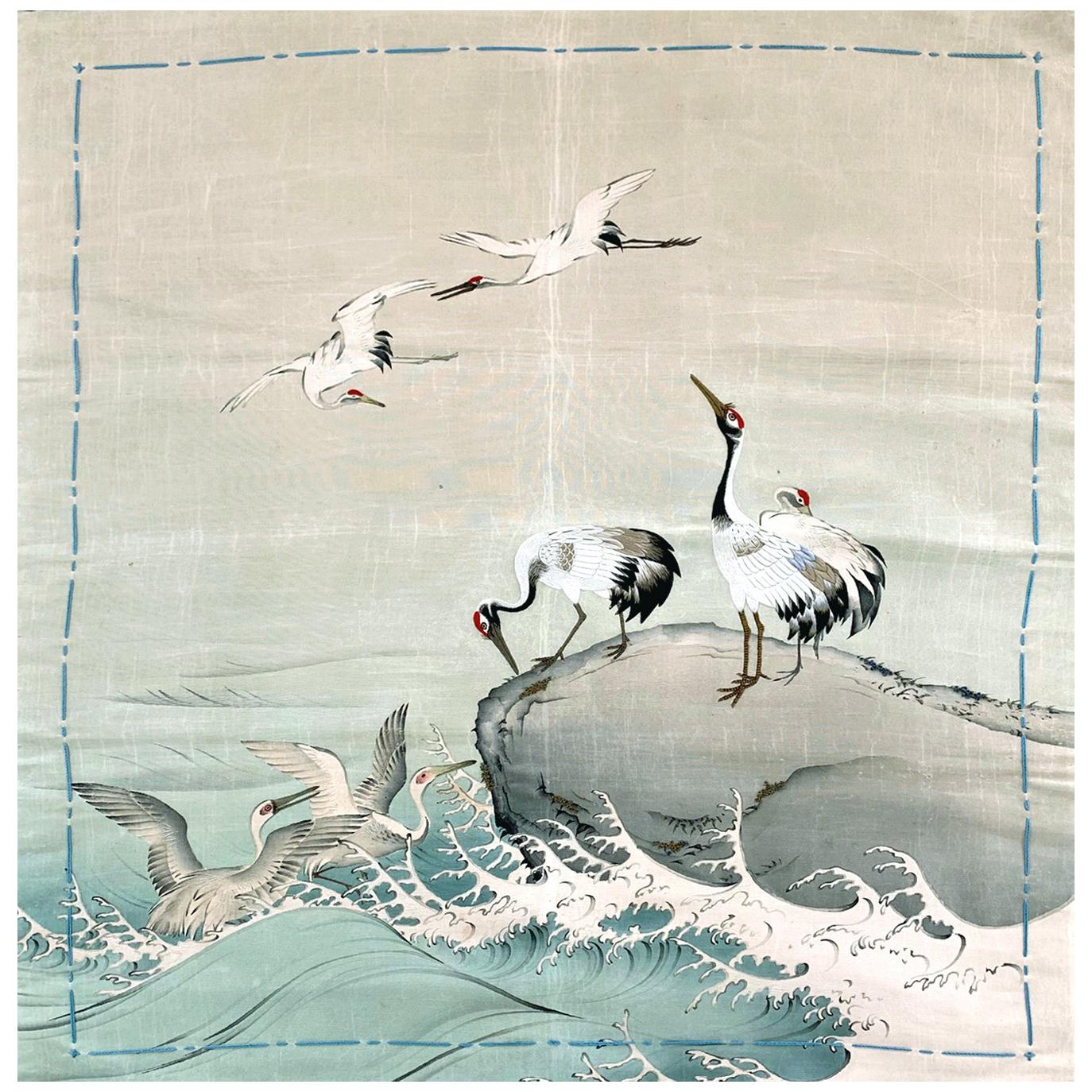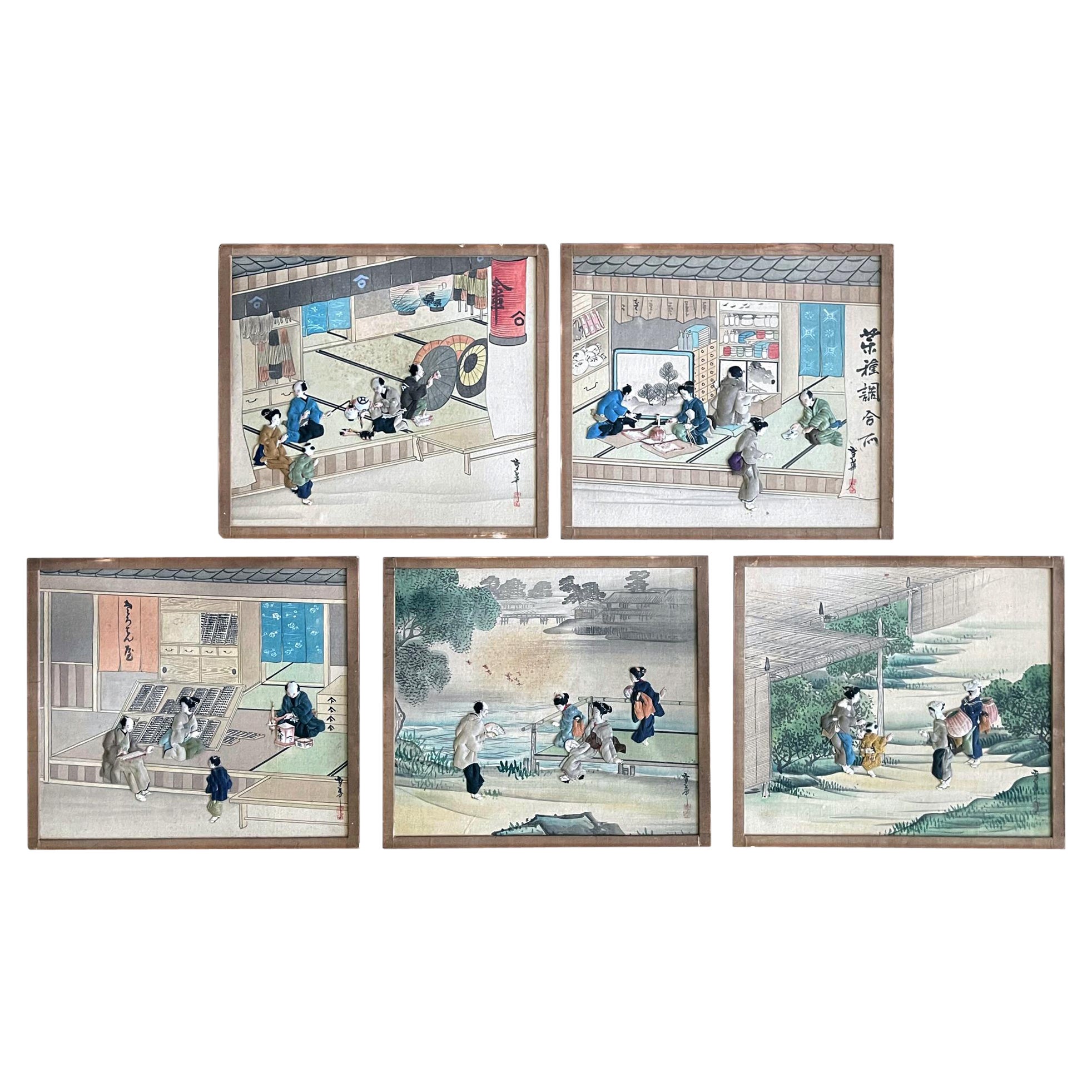Items Similar to Japanese Antique Fukusa Textile Art Meiji Period
Want more images or videos?
Request additional images or videos from the seller
1 of 16
Japanese Antique Fukusa Textile Art Meiji Period
About the Item
A Japanese silk Fukusa panel circa late 19th-early 20th century of Meiji Period. The front was beautifully decorated with Yuzen-zome, a labor intensive resist-dye technique invested by an artist monk Miyazaki Yuzensai (1654 -1736) of Edo period. It depicts two of the shichifukujin (seven gods of fortune in Japanese mythology) on a small boat. On the left is Ebisu, the patron of fishermen who symbolizes abundance in foods. On the right side is Hotei, the god of fortune, guardian of the children, patron of diviners and barmen, and also the god of popularity. The two gods seem to be engaging in a conversation with their boat docking on a small rock in the middle of ocean waves. The sun rises in the far distant haze with two cranes in flight. A Mon symbol in gold thread was embroidered on the lower left side indicates the family crest. Yuzen resistant dye was used by a master's hand to render the subtle effects of the waves and the gradual haze. Embroidery was used sparsely in a very refined manner to highlight the small area of the costumes. Tiny beads were used to depict the splashes of the water. It is truly a beautiful piece of textile art done with astounding techniques.
The piece has a red floral silk backing and still retains three of the four tassels with a crystal bead on corners, as well as decorative stitches along the edges.
Fukusa is a traditional Japanese textile art used as a panel for presenting gifts at important occasions. It tends to carry a family crest.
- Dimensions:Height: 27 in (68.58 cm)Width: 26 in (66.04 cm)Depth: 0.1 in (2.54 mm)
- Style:Japonisme (Of the Period)
- Materials and Techniques:
- Place of Origin:
- Period:
- Date of Manufacture:Early 20th Century
- Condition:Wear consistent with age and use. Antique textile condition, one small dark mark, minor discoloration/stains, small holes on the silk backing, missing one tassel, folding lines from storage. Unframed, all as shown.
- Seller Location:Atlanta, GA
- Reference Number:1stDibs: LU945017943772
About the Seller
5.0
Platinum Seller
These expertly vetted sellers are 1stDibs' most experienced sellers and are rated highest by our customers.
Established in 2006
1stDibs seller since 2010
480 sales on 1stDibs
Typical response time: <1 hour
- ShippingRetrieving quote...Ships From: Atlanta, GA
- Return PolicyA return for this item may be initiated within 2 days of delivery.
More From This SellerView All
- Japanese Antique Fukusa Textile Art Meiji PeriodLocated in Atlanta, GAA Japanese silk Fukusa panel circa late 19th-early 20th century of Meiji Period. The front was beautifully decorated with Yuzen-zome, a labor intensive resist-dye technique invested by an artist monk Miyazaki Yuzensai (1654 -1736) of Edo period. The front cover likely depicts a scene from the Tale of Genji, showing a nobleman and his servant pays a visit to a lady in a fenced thatch-roof house under a high peak. The details of blossom trees and pines, as well as the characters, and scenery with a gradual color are astounding. It is telling that the Yuzen dying was used such an mastery. The piece has a red silk backing and still retains two red tassels on the lower corners as well as decorative stitches along the edges. There is a patched design on the back likely a Mon symbol (family crest). Fukusa is a traditional Japanese textile...Category
Early 20th Century Japanese Japonisme Textiles
MaterialsSilk
- Japanese Antique Fusuka Textile Art Meiji PeriodLocated in Atlanta, GAA Japanese silk Fukusa panel circa late 19th-early 20th century of Meiji Period. The front was beautifully decorated with Yuzen-zome, a labor intensive resist-dye technique invested by an artist monk Miyazaki Yuzensai (1654 -1736) of Edo period. The auspicious composition features a group of red-crown cranes, the symbol of longevity. Three of them perch on the rock by the ocean (East Sea) an two of them are in flight. Additionally, two egrets frolic in the wave. Yuzen dying was used extensively to showcase the amazing details such as the waves and the gradual coloring effect. Embroidery was used sparsely to highlight areas such as the legs of the crane to render it more dimensional details. The piece has a red silk backing and still retains four blue tassels on corners as well as decorative stitches along the edges. Fukusa is a traditional Japanese textile...Category
Early 20th Century Japanese Japonisme Textiles
MaterialsBrocade, Silk
- Framed Japanese Fukusa Textile Art Meiji PeriodLocated in Atlanta, GAA Japanese Fukusa textile panel circa late 19th-early 20th century of Meiji Period. On the woven brocade background with gold thread forming clouds and...Category
Antique Late 19th Century Japanese Japonisme Textiles
MaterialsSilk, Giltwood
- Collection of Five Japanese Oshi-E Textile Art Panels Meiji PeriodLocated in Atlanta, GAOn offer is a set of five Japanese textile art panels called Oshi-E circa Meiji Period (1868-1912). This usual set of panels depict various aspects of daily life in Edo time with beautiful details. Some of these panels are snapshots of the buzzling commercial activities at the marketplace, providing insight into the signages, architecture, costumes and how people interacted within a historical and pictorial context. Other panels depict daily leisure activities such as lounging in the park or visiting friends. The realistic rendering and attention to details are not short of "photographic" quality. From the signage of the shops to the motions and attires of the individual characters, from the hairstyle, small ornaments, down to the facial expression, were all recorded in great details. Each panel was signed with the artist's name Yukihana in Kanji with a red seal. These panels are unframed and await your custom touch (framing with inner gilt spacer and mat costs about 250-500 depending on the material chosen, see a framed example in the last picture of a single framed panel we have for sale). We offer them for sale individually, but it will be great for a collector to consider the whole set so that they can stay together. The Oshi-E (also known as kiritori zaiku) is a type of ornamental textile art dated back to the Muromachi period (1392-1573). It started among the elite aristocratic women in Kyoto before spreading wider in the Japanese society. Throughout Edo and Meiji period, Oshi-E were sometimes used to make offerings to the altars in the temple and in the late 19th century, it was exported to the west along with the other embroidery textile art. Oshi-E was made by using silk wadding to create a relief design. Various silk fabric swaps and sometimes wires and tassels, often recycled from older kimonos...Category
Antique 1890s Japanese Japonisme Textiles
MaterialsSilk, Giltwood
- Rare Historical Set Japanese Oshi-E Textile Art Panels Meiji PeriodLocated in Atlanta, GAOn offer here is a rare set of eleven Japanese textile art with painting panels called Oshi-E circa Meiji Period (1868-1912). This unusual set of panels depict various composition of...Category
Antique Late 19th Century Japanese Meiji Textiles
MaterialsSilk, Fabric, Paper
- Japanese Fukusa Relief Embroidery Textile Art of DragonLocated in Atlanta, GAA visually stunning Japanese fukusa panel with an embroidered dragon on a swirling cloud background, nicely displayed on a scarlet felt matt in a carve...Category
Antique 1890s Japanese Japonisme Textiles
MaterialsSilk, Wood
You May Also Like
- Antique Burnt Orange and Purple Silk TextileLocated in New York, NYStunning contrasting colors featuring a metallic fringe on this beautiful fine silk, tie dye ceremonial shoulder cloth from Palembang, Sumatra. Early 20 century. There are 2 very small holes shown on the last image, to be expected due to the age. We only source the best. This beautiful shawl can be worn or used as a wall hanging framed...Category
Early 20th Century Indonesian Tribal Textiles
MaterialsSilk
- Andrianna Shamaris Linen and Cotton Antique Textile from Toraja LandLocated in New York, NYStriking “pelangi” tie-dyed textile from Toraja Land, South Sulawesi. We added a linen border, double backed on both ends. This beautiful panel can be used as a wall hanging, draped ...Category
Mid-20th Century Indonesian Tribal Textiles
MaterialsCotton, Linen
- Late Meiji Period Sleeping Kimono / Yogi, JapanLocated in Point Richmond, CALate Meiji Period sleeping Kimono / Yogi, Japan Yogi are a type of oversized sleeping kimono traditionally used in Japan. This kimono would have b...Category
Early 20th Century Japanese Tribal Textiles
MaterialsCotton
- Vintage Kimono Silk Brocade Japanese Ceremonial 1970Located in North Hollywood, CAA vintage Mid-Century ivory color silk brocade collectable Japanese ceremonial kimono. One of a kind. Fabulous museum quality ceremonial kimono in pure silk with intricate detailed h...Category
20th Century Japanese Japonisme Textiles
MaterialsSilk
- Andrianna Shamaris Linen and Cotton Antique Textile from Toraja LandLocated in New York, NYStriking "pelangi" tie-dyed textile from Toraja Land, South Sulawesi. We added a linen border, double backed on both ends. This beautiful panel can be used as a wall hanging, draped ...Category
Mid-20th Century Indonesian Tribal Textiles
MaterialsCotton, Linen
- Meiji Period Japanese Indigo Double Ikat Futon CoverLocated in Point Richmond, CAMeiji period Japanese Indigo double ikat futon cover Japanese futon cover, a double ikat pattern in four panels depicting Kumamoto Castle with im...Category
Antique 1890s Japanese Meiji Textiles
MaterialsCotton





